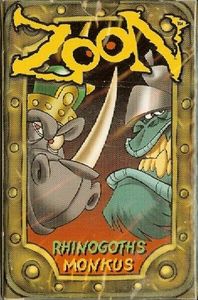As you may have known by now, we were driven from our home by barbarians. Luckily, we were able to find a new place to call home. But if they expect me to explore these filthy caves, they've just got to find someone else. How could you dare ask such a business man as myself to stoop to...manual labor? I could get dirty! Just because we are desperate doesn't mean we're savages. I have my place, the workers have theirs, Above and Below, respectively. Well, it is time for me to open shop, I need to get downstairs and see how the tots are working along.
Formally yours,
Franklin Delaware Worthington, the IV

BACKGROUND: Above and Below is a 2-4 worker management board game. It was created in 2015 by Ryan Laukat and published by Red Raven Games. Players build strong, working villages while exploring a cave system in a limited amount of time.
GAMEPLAY: The game is played in 7 rounds. Every round, each player may take an action on their turn. If a player doesn't want to, they can pass to stop taking actions. The round ends once all players pass.
ACTIONS: To take an action, players move the appropriate villagers to the Exhausted area, and take the action.
- Explore: Roll the die and draw a cave card. The player to the left reads the encounter, the possible choices and requirements, but not the rewards. The player makes a choice and rolls the dice to try to get the lanterns. If a player does not get them, some encounters will have a fail condition that is read, some do not. Players may also move villagers to the Injured area to get another lantern.
- Build: Players may pay coins to build houses, which have various effects. Outposts may only be bought if the player has an empty cave card to place it in.
- Harvest: Players take a Good that their house or outpost produces, 1 per villager used.
- Labor: Players gain 1 coin per villager. The first player to do this gains the Cider token that round. Goods can be placed on the Advancement track at the bottom of the board (1 per slot), or kept off to the side.
- Train: Buy an available villager according to the cost on the board, and place it in the exhausted area.
There are also 3 free actions players may take whenever they want before they take their normal action: Take 1 Good, Potion, or Cider and put it for sale (upper left corner of the player board), buy from another player (3 coins), or once a turn, discard and replace all building cards in a row.

WINNING: At the end of the 7th round, each player totals up their Village Points. Village Points are indicated in heptagons. Each building is worth 1 VP. Each slot on the Advancement track is worth an amount of VP. VP for reputation is determined by who is highest, with points awarded appropriately. Some cards give bonus VP, or VP for having
CONCLUSION: This is a nice worker placement game that starts out a little tricky to learn. The encounter book really helps sell this world, and adds a bit of flavor and theme that could easily be generic. The biggest problem is that this game is surprisingly fast, which prevents players from a long term, deep strategy. This game is a lot of fun, it just would be better if it was a few turns longer.


/pic300648.jpg)

/pic208427.jpg)